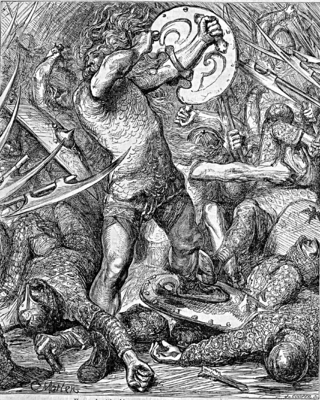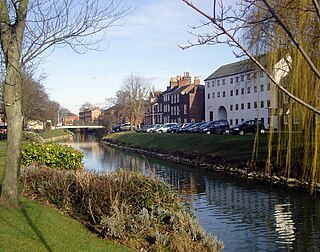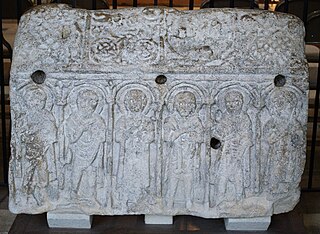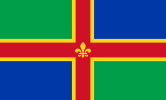
Mercia was one of the three main Anglic kingdoms founded after Sub-Roman Britain was settled by Anglo-Saxons in an era called the Heptarchy. It was centred on the River Trent and its tributaries, in a region now known as the Midlands of England.

Hereward the Wake was an Anglo-Saxon nobleman and a leader of local resistance to the Norman Conquest of England. His base when he led the rebellion against the Norman rulers was the Isle of Ely, in eastern England. According to legend, he roamed the Fens, which covers parts of the modern counties of Cambridgeshire, Lincolnshire and Norfolk, and led popular opposition to William the Conqueror.

Crowland or Croyland is a town in the South Holland district of Lincolnshire, England. It is situated between Peterborough and Spalding. Crowland contains two sites of historical interest, Crowland Abbey and Trinity Bridge.

The Fens or Fenlands in eastern England are a naturally marshy region supporting a rich ecology and numerous species. Most of the fens were drained centuries ago, resulting in a flat, dry, low-lying agricultural region supported by a system of drainage channels and man-made rivers and automated pumping stations. There have been unintended consequences to this reclamation, as the land level has continued to sink and the dykes have been built higher to protect it from flooding.

The Midlands is the central part of England, bordered by Wales, Northern England, Southern England and the North Sea. The Midlands correspond broadly to the early-medieval kingdom of Mercia, and later became important in the Industrial Revolution of the 18th and 19th centuries. They are now split into two official regions, the West Midlands and East Midlands. The Midlands' biggest city, Birmingham, is the second-largest in the United Kingdom. Other important cities include Coventry, Derby, Leicester, Lincoln, Nottingham, Stoke-on-Trent, Wolverhampton, and Worcester.

Spalding is a market town on the River Welland in the South Holland district of Lincolnshire, England. The town had a population of 34,113 at the 2017 census. The town is the administrative centre of the South Holland District. The town is located between the cities of Peterborough and Lincoln, as well as the towns of Bourne, Market Deeping, March, Boston, Wisbech, Holbeach and Sleaford.

Monks Kirby is a village and civil parish in north-eastern Warwickshire, England. The population of the parish is 445. Monks Kirby is located around one mile east of the Fosse Way, around 8 miles north-west of Rugby, seven miles north-east of Coventry and six miles west of Lutterworth. Administratively it forms part of the borough of Rugby. One of the largest and most important villages in this part of Warwickshire in the Anglo-Saxon and later medieval period, the village continued to be a local administrative centre into the early 20th century.

Saint Guthlac of Crowland was a Christian hermit and saint from Lincolnshire in England. He is particularly venerated in the Fens of eastern England.

Crowland Abbey is a Church of England parish church, formerly part of a Benedictine abbey church, in Crowland in the English county of Lincolnshire. It is a Grade I listed building.

Medeshamstede was the name of Peterborough in the Anglo-Saxon period. It was the site of a monastery founded around the middle of the 7th century, which was an important feature in the kingdom of Mercia from the outset. Little is known of its founder and first abbot, Sexwulf, though he was himself an important figure, and later became bishop of Mercia. Medeshamstede soon acquired a string of daughter churches, and was a centre for an Anglo-Saxon sculptural style.

Shelford Priory is a former Augustinian Monastery located in the village of Shelford, Nottinghamshire, United Kingdom. The priory was founded by Ralph Haunselyn around 1160–80 and dissolved in 1536. Little remains of the original priory. Following dissolution it was granted to Michael Stanhope, and c.1600 Shelford Manor was constructed on the site. The manor was fortified and then partially destroyed during the English Civil War. The house was reconstructed c.1678, however, it was altered in the 18th and 19th centuries. It is now known as Shelford Manor and is a private residence.

Bardney Abbey in Lincolnshire, England, was a Benedictine monastery founded in 697 by King Æthelred of Mercia, who was to become the first abbot. The monastery was supposedly destroyed during a Danish raid in 869. In 1087, the site was refounded as a priory, by Gilbert de Gant, Earl of Lincoln, and it regained status as an abbey in 1115.

Eadnoth the Younger or Eadnoth I was a medieval monk and prelate, successively Abbot of Ramsey and Bishop of Dorchester. From a prominent family of priests in the Fens, he was related to Oswald, Bishop of Worcester, Archbishop of York and founder of Ramsey Abbey. Following in the footsteps of his illustrious kinsman, he initially became a monk at Worcester. He is found at Ramsey supervising construction works in the 980s, and around 992 actually became Abbot of Ramsey. As abbot, he founded two daughter houses in what is now Cambridgeshire, namely, a monastery at St Ives and a nunnery at Chatteris. At some point between 1007 and 1009, he became Bishop of Dorchester, a see that encompassed much of the eastern Danelaw. He died at the Battle of Assandun in 1016, fighting Cnut the Great.
Axholme Charterhouse or Axholme Priory, also Melwood Priory or Low Melwood Priory, North Lincolnshire, is one of the ten medieval Carthusian houses (charterhouses) in England. It was established in 1397/1398 by Thomas Mowbray, Earl of Nottingham and later Duke of Norfolk. The house was centred on a pre-existing chapel on the present Low Melwood Farm, between Owston Ferry and Epworth in the Isle of Axholme, which according to a papal bull of 1398 "was called anciently the Priory of the Wood".
The Spaldingas were an Anglian tribe that settled in an area known as the Spalda. This divided the fens and marshes of East Anglia in what is now the South Holland part of Lincolnshire. As well as establishing the town of Spalding, first mentioned in a charter by King Æthelbald of Mercia to the monks of Crowland Abbey in 716, they also gave their name to area of Spalding Moor and the village of Spaldington in East Yorkshire.

St Oswald's Priory was founded by Æthelflæd, daughter of Alfred the Great, and her husband Æthelred, ealdorman of Mercia, in the late 880s or the 890s. It appears to have been an exact copy of the Old Minster, Winchester It is a Grade I listed building.

Monks Kirby Priory was a Benedictine priory established in 1077 in Monks Kirby, Warwickshire, England. The priory was suppressed in 1415 when its estates and revenues were given to the Carthusian priory of Axholme in Lincolnshire, in whose possession they continued until the Reformation. Remains of the priory form part of Monks Kirby village church today.

The Church of St Mary and St Nicolas is an active Church of England parish church in Spalding, Lincolnshire, England. It was built c. 1284 on the site of an earlier church, and is a Grade I listed building.
The Tofts is a 0.8–1 km-wide band of raised ground along part of the Lincolnshire coast, running between Wainfleet All Saints and Wrangle parallel to the Wash.
Herbert Enoch Hallam, FAHA (1923–1993) was an English-born historian who spent most of his academic career in Australia. He was professor of medieval history at the University of Western Australia between 1966 and 1988.


















